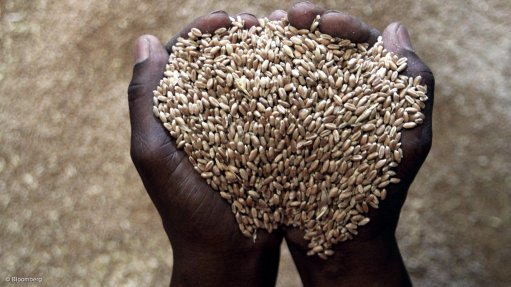Energy metal demand to outpace output in wake of $20bn battery build boom
VANCOUVER (miningweekly.com) – “The megafactories are coming.”
This is the mantra of market analyst, founder and MD of Benchmark Mineral Intelligence Simon Moores, citing research showing more than $20-billion currently committed to creating new, or expanding existing lithium- (Li-) ion battery cell plants.
This will take global production capacity from megawatt to gigawatt territory, with the bulk of the activity taking place in China, where massive tooling operations are currently under way.
According to Moores, South Africa-born entrepreneur Elon Musk’s Nevada-based Tesla Gigafactory, which is expected to start production later this year, is leading the 'capacity revolution', with a planned total installed production capacity of 35 GWh by 2020. Other significant expansions include LG Chem Korea, which is more than doubling Li-ion battery output to 20 GWh, and the Chinese Lishen and CATL plants, which are both upgrading from below 5 GWh, to 20 GWh and 25 GWh, respectively.
Lithium-ion battery costs are also falling at an increasing rate, Moores notes. Since 2000, when it cost more than $2 500 for a battery, costs have declined by 12% to 14% a year up to 2015, with Moores expecting that rate to quicken to between 15% and 20% a year between 2016 and 2020.
ENERGY STORAGE
Addressing a crowd of investors in Vancouver on Thursday, on the eighth of 11 stops on the Benchmark World Tour 2016, Moores declared energy storage as the new oil, just like uranium was a buzzword in 2007, lithium in 2010 and 2016 and fracking and frack sands were in 2011/12.
“The ability to store energy is the game changer, entailing pure electric vehicles (EVs), mainstream solar power generation and modern smart grids, using peak shifting grid energy storage technologies. The impact on solar power will be revolutionary, as the low cost and abundance of lithium-ion batteries will cheapen the cost of energy storage, improving the economic sensibility for mainstream applications,” he explained.
He argues that it is quite viable for solar to challenge crude oil’s dominance.
However, the rechargeable battery industry is relatively young, with the first commercial lithium-ion battery only produced in 1991.
Noting that some of the very first EVs were already built in the early 1800s, Moores explained that the rechargeable battery industry is currently moving into a fourth phase in its evolution. This entails the large-scale adoption of full EVs and utility storage applications, reflecting increasing battery entrenchment in everyday life, which itself benefited from mobile devices gaining real traction from 2006 onwards.
“The bottom line,” Moores states, “is that on the way to half-a-terawatt in battery-building capacity, raw materials need to evolve to supply the unprecedented demand growth from battery manufacturers by 2025.”
EARLY MOVERS
Answering the call, Moores noted, were some oil majors moving into the emerging battery manufacturing market. French oil firm Total had earlier this year taken control of battery manufacturer Saft Groupe. “They are moving in on a battery-powered race sparked by tech industrialists such as Musk, and this has resulted in an arms race of sorts,” Moores stated.
This trend has now evolved. Silicone Valley is investing into this sphere, with the likes of Apple, Google and Amazon establishing energy affiliates and Tesla leading the auto industry, adding further momentum. “Elon started it, but China will probably finish it,” Moores said.
Lithium supply in 2015 comprised about 160 000 t. However, to keep up with the projected demand increase by 2020, the market will have to supply between 100 000 t/y and 120 000 t/y to keep the market in balance.
However, regaining balance is unlikely since mine development entails long lead times of between four and seven years. Moores does not expect any meaningful new production to come on stream before 2020, projecting a 30 000 t/y supply growth until then.
Meanwhile, more expensive Australian spodume production is expected to fill the gap.
While Australia, Chile and Argentina are the significant sources of lithium-equivalent feedstock, Moores pointed out that the Chinese remained the dominant supplier of lithium carbonate and hydroxide.
Signs point to surging battery demand in China, with long-term orders “through the roof”, according to Moores.
“The major manufacturers are preparing for a four- to six-fold increase in cathode buying by 2020. Even Tesla will initially have to source lithium hydroxide from China,” Moores advised. Lithium hydroxide is the preferred material used to make Li-ion batteries.
Year-to-date, Benchmark's lithium price index has risen 58.4%, after having more than doubled in the past 12 months alone.
GRAPHITE GROWTH
Meanwhile, demand for other energy metals such as graphite, which is used in the anode side of Li-ion batteries, is also increasing.
Feedstock supply in 2015 totalled about 400 000 t, with Chinese output accounting for 66% of the market. Uncoated spherical graphite supply in 2015 was virtually monopolised by China.
According to Benchmark, between 150 000 t/y and 170 000 t/y of additional graphite anode supply is needed by 2020 to keep the market in balance.
The anode market output totalled 80 000 t in 2015, produced from about 110 000 t of flake graphite feedstock. By 2020, the graphite market will increase to between 250 000 t/y and 400 000 t/y, requiring between 325 000 t/y and 365 000 t/y in feedstock to keep up with demand.
While prices trend upwards, Moores noted that the forward-looking price range of uncoated spherical graphite was widening, owing to lower-grade and divergent quality streams entering the market.
Northern Graphite CEO Greg Bowes noted that it would not take a lot of EVs to affect the graphite market. With around 400 000 preorders for the Model 3 EV, this translates to about 100 000 t of large-flake graphite and multiple new mines required to fill the growing demand.
Nevada Sunrise Gold president and CEO Warren Stanyer forecast that, by 2040, 41-million EVs would be produced each year.
COBALT UPDATE
Looking at cobalt, which gives superior energy density to modern Li-ion batteries when used in cathode chemistries, Moores noted that prices had started to rise about 10%, as structural market issues persisted.
The critical energy metal is mainly produced in the Democratic Republic of Congo (DRC), where ethical production remains a big question mark on downstream supply chains.
“This arguably makes it the most critical of the critical metals. The geographic location of most production makes supply chain visibility an issue,” Moores said.
Further, about 75% of cobalt output is the result of by-product from copper and nickel processing, making the supply response even more unresponsive, Moores noted, pointing to the decline in base metals prices prompting producers to react by cutting production.
According to Moores, the cobalt market was still looking for “supply chain leaders”.
Comments
Press Office
Announcements
What's On
Subscribe to improve your user experience...
Option 1 (equivalent of R125 a month):
Receive a weekly copy of Creamer Media's Engineering News & Mining Weekly magazine
(print copy for those in South Africa and e-magazine for those outside of South Africa)
Receive daily email newsletters
Access to full search results
Access archive of magazine back copies
Access to Projects in Progress
Access to ONE Research Report of your choice in PDF format
Option 2 (equivalent of R375 a month):
All benefits from Option 1
PLUS
Access to Creamer Media's Research Channel Africa for ALL Research Reports, in PDF format, on various industrial and mining sectors
including Electricity; Water; Energy Transition; Hydrogen; Roads, Rail and Ports; Coal; Gold; Platinum; Battery Metals; etc.
Already a subscriber?
Forgotten your password?
Receive weekly copy of Creamer Media's Engineering News & Mining Weekly magazine (print copy for those in South Africa and e-magazine for those outside of South Africa)
➕
Recieve daily email newsletters
➕
Access to full search results
➕
Access archive of magazine back copies
➕
Access to Projects in Progress
➕
Access to ONE Research Report of your choice in PDF format
RESEARCH CHANNEL AFRICA
R4500 (equivalent of R375 a month)
SUBSCRIBEAll benefits from Option 1
➕
Access to Creamer Media's Research Channel Africa for ALL Research Reports on various industrial and mining sectors, in PDF format, including on:
Electricity
➕
Water
➕
Energy Transition
➕
Hydrogen
➕
Roads, Rail and Ports
➕
Coal
➕
Gold
➕
Platinum
➕
Battery Metals
➕
etc.
Receive all benefits from Option 1 or Option 2 delivered to numerous people at your company
➕
Multiple User names and Passwords for simultaneous log-ins
➕
Intranet integration access to all in your organisation





















